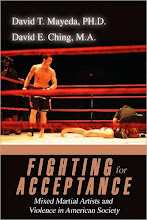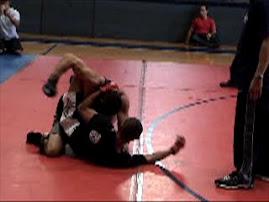 This blog is quickly turning into the “Sports Sociology Blog.” LeBron James of the Cleveland Cavaliers recently came out with a book titled Shooting Stars, co-authored with Buzz Bissinger. As such, James has been making the rounds across talk radio. He was recently interviewed on NPR’s Fresh Air with Terry Gross (9/9/09) and then on Talk of the Nation with Neal Conan (9/15/09).
This blog is quickly turning into the “Sports Sociology Blog.” LeBron James of the Cleveland Cavaliers recently came out with a book titled Shooting Stars, co-authored with Buzz Bissinger. As such, James has been making the rounds across talk radio. He was recently interviewed on NPR’s Fresh Air with Terry Gross (9/9/09) and then on Talk of the Nation with Neal Conan (9/15/09).I particularly enjoyed the first interview with Gross in which James discusses his childhood friendships (that serve as the basis for his book), racial politics in high school athletics, getting dunked on, and his relationship with his mother. I noticed one of his comments illustrates the way that popular culture subdues social resistance in contemporary society. From a transcript of the interview:
GROSS: You're one of the people who went very suddenly from poverty to wealth. You write in your book, you know, your mother had you when she was 16. Her mother died when you were three. It was hard for your mother to support you. You had to keep moving a lot because of eviction notices and, you know, rent problems. Did you think of basketball as a way out, as more than just a game?
Mr. JAMES: Oh, I think it is more than a game. Basketball, and I think sport period, gives you an opportunity to forget about anything that may be going on in your life, back away from that particular sport that you may be playing. You know, I definitely used the game to get my mind off some of the bad things that may have been going on as a child.
GROSS: Like what?
Mr. JAMES: You know, just things you never want your kids to see, you know, violence and things like that. You never want your kids to see that. So, you know, I used the game of basketball to keep me away from that.
While it is unclear from what type of violence (e.g., family) James was escaping when playing basketball, what is clear is that in escaping from the violence, the violence went unchallenged by James. Granted, James was describing a time when he was a minor, so this example is not to be taken literally by suggesting James should have been expected to challenge the violent perpetrator(s).
Rather, James’s comments exemplify one of the functions of popular culture in a society rooted in conflict – to help the exploited escape temporarily from their problems, thereby allowing the exploiters to go about their business unchallenged by the masses. From John Storey’s An Introductory Guide to Cultural Theory and Popular Culture:
The function of the culture industry is therefore, ultimately, to organize leisure time in the same way as industrialization has organized work time. Work under capitalism stunts the senses; the culture industry continues the process: ‘the escape from everyday drudgery which the whole culture industry promotes … [is a] paradise … [of] the same old drudgery … escape … [is] predesigned to lead back to the starting point. Pleasure promotes the resignation which it ought to help to forget.’ In short, work leads to mass culture; mass culture leads back to work. (p. 105, 106).
In other words, those who are victims of violence in various settings (e.g., family, work, school, religion), can temporarily go off and play a game of pickup, catch a movie, take a vacation, pray, or engage in whatever form of leisure/escape they choose. Doing so simply recharges the victims’ batteries, makes them feel rewarded, and ultimately encourages them to return to their place of exploitation. Popular culture and leisure activities are part of the capitalist system, secretly painted as social rewards. In reality, sporting and leisure industries in general help those in power go unchallenged.
Today, sporting institutions have become so popular that society virtually ignores the way athletic industries symbolize and perpetuate global exploitation. Unlike some athletes from yesteryear who cared about social issues and actually attempted to do something about them (Martina Navratilova, Muhammad Ali, Arthur Ashe, Jackie Robinson), today’s LeBron James, Tiger Woods, the Williams Sisters, Roger Federer and so on, follow the lead of an utterly apolitical Michael Jordan.
Corporate ties to athletic industries, such as Nike, inhibit athletes from using their social power in ways that oppose the most hideous forms of globalization. In the 1980s and beyond, multinational corporations shifted in five ways that perpetuate global disparities:
- …1890s firms largely employed Americans to produce their product; in the 1990s, the firms extensively employed foreign labor and made the overwhelming bulk of their goods abroad.
- …while the late-nineteenth-century firms largely traded in natural resources (oil, iron) or industrial goods (steel, paint), the late-twentieth-century firms traded in designs, technical knowledge, management techniques, and organizational innovations.
- A third characteristic of transnationals, such as Nike or Coca-Cola, was their increasing dependence on world markets – not solely U.S. – for profits.
- …transnationals of the late twentieth century depended on massive advertising campaigns to make people want their products…. Such advertising often sold not merely a product (as sneakers), but a lifestyle (“Just Do It”) that in most instances was based on American culture.
- The new transnational…became so global by the 1980s that a single government had power over only a part o the firm’s total operation… Thus, for example, when the makers of athletic equipment were found in the 1990s to be exploiting low-paid Southeast Asians who worked in horrible conditions, the U.S. government’s power to remedy the problem was limited. The transnational was, as its name declared, transcending the boundaries of individual nations.
From Michael Jordan and the New Global Capitalism (LaFeber, 2002, p. 55-57).
Today, transnational corporations (like Nike) continue to exploit Southeast Asian workers and only claim awareness of the exploitation and do something about it after it has been exposed by others (see below).
In the meantime, society’s athletes and sports fans go about getting ready for the next sporting event while the corporate executives' oppressive and global work-leisure-work system goes on unchallenged.
(Photo courtesy of NPR).









I think it's worth thinking about LeBron James as a child versus LeBron James as a multi-millionaire adult, though. In other words, there's definitely a power differential here. Perhaps there's some value to "escaping the violence" for a child--one that would seem to have a relative lack of power to control the system of violence in which he had been living. Perhaps just surviving the violence and proceeding to make a lot of money provides a path to social resistance? Or maybe that's an illusion, too. I do think it's a totally different story when it comes to adult, wealthy athletes: arguably, they have supreme power to challenge the whole work-leisure-work system, and that's what I think the bulk of this post is about. I wonder what James does, as an adult, to challenge that system, and what role the whole "giving back to my community" narrative--and reality--plays in challenging this system (or reinforcing it. or both.)? I do think there's a difference between what a child can and should do to challenge the system, compared to what an adult--especially a superstar athlete--can and should do. I guess it gets down to children's power and agency... but that's another whole discussion! Thanks for the post.
ReplyDeleteHi Clare, you're absolutely right. I very briefly mentioned that issue of James being a minor at the time in my post (right after the interview with Terry Gross). I probably should have emphasized his age at the time more.
ReplyDeleteGood point about "giving back to his community" now as a young adult -- what does that mean, and how far does he take it? Thanks for the commment!